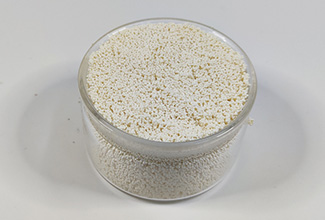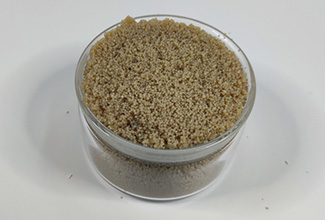Ion Exchange Resin Regeneration Method
1. Conventional Resin Regeneration Methods
After a period of use, ion exchange resins gradually accumulate adsorbed impurities, leading to a saturation state and a decline in performance. At this point, regeneration is required to restore the resin's original ion exchange capacity and other physical-chemical properties. Ion exchange regeneration is typically achieved by using chemical agents to elute the ions and other impurities adsorbed by the resin. In practical applications, to reduce regeneration costs, it is common to control the amount of regenerant used, restoring the resin’s performance to an economically optimal level, usually around 70-80% recovery. To achieve higher regeneration levels, larger amounts of regenerant are needed, but this can result in decreased regenerant efficiency and increased operational costs.
The regeneration process should be chosen based on the resin type, characteristics, and economic considerations. The regeneration performance is closely related to the type and structure of the resin. Strong acid and strong base resins are more difficult to regenerate and generally require more regenerant than theoretical values. In contrast, weak acid or weak base resins are easier to regenerate and require slightly more regenerant than the theoretical amount. Additionally, macroporous and low cross-linked resins are easier to regenerate, while gel-type and high cross-linked resins require longer reaction times for regeneration.
The choice of regenerant should be based on the ion type of the resin. For example, sodium-type strong acid cation resins can be regenerated using a 10% NaCl solution, with the required amount being approximately twice the resin's exchange capacity (about 117g/L of resin). Hydrogen-type strong acid resins are typically regenerated using strong acids, such as sulfuric acid. However, care must be taken to prevent the calcium ions adsorbed on the resin from reacting with sulfuric acid to form calcium sulfate precipitates. Therefore, it is common practice to first use a 1-2% dilute sulfuric acid solution for regeneration.
For chloride-type strong base resins, a 10% NaCl solution combined with 0.2% NaOH is often used for regeneration, with typical usage being 150-200g NaCl and 3-4g NaOH per liter of resin. OH-type strong base anion resins are regenerated with a 4% NaOH solution. Regeneration involves reversing the ion-exchange process, and according to chemical equilibrium principles, increasing the concentration of one side of the chemical reaction can help drive the reaction toward the opposite side, thus accelerating the regeneration process and achieving a higher recovery level.
To speed up the regeneration reaction, the regenerant is usually heated to 70-80°C, with a flow rate of 1-2 BV/h (bed volumes per hour). In some cases, a “fast then slow” method may be applied to maximize the regenerant's effectiveness. The regeneration time generally lasts about one hour. Afterward, soft water is used for countercurrent rinsing for about one hour (about 4 BV of water), until the wash water runs clear. The resin is then backwashed until the effluent is clear and free of turbidity.
Some resins, especially decolorizing resins such as weak base resins, may still exhibit some alkalinity after regeneration and backwashing, especially if a strong alkali was used in the regeneration process. These types of resins typically work best in mildly acidic conditions. To adjust the pH, dilute hydrochloric acid is introduced to lower the resin’s pH to around 6, followed by a fresh water rinse and another backwash.
After prolonged use, resins may become contaminated by adsorbed large molecular organic colloidal substances, which are difficult to remove through conventional regeneration methods. These contaminants gradually accumulate, reducing the resin’s performance. In such cases, special treatment methods are needed. For example, when cation resins are contaminated by nitrogen-containing amphoteric compounds, they can be treated with a 4% NaOH solution to dissolve the contaminants. If anion resins are contaminated with organic materials, the NaOH concentration in the regeneration solution can be increased to 0.5-1.0% to better dissolve the organic matter.
2. Special Resin Regeneration Methods
When resins are severely contaminated, conventional regeneration methods may not be sufficient to remove all the impurities. In such cases, more complex treatments are used. For example, an initial treatment with a 10% NaCl and 1% NaOH solution can be used to dissolve organic contaminants, followed by treatment with a 4% HCl solution or sequential treatments with 10% NaOH and 1% HCl to dissolve inorganic impurities. The resin is then treated again with a 10% NaCl and 1% NaOH solution. This process is typically conducted at a temperature of around 70°C to enhance the effect.
If the above treatments do not yield the desired results, oxidation can be used as a final step. This involves washing the resin with water, followed by passing a 0.5% sodium hypochlorite solution through the resin bed. The flow rate is controlled at 2-4 BV/h, with a throughput of 10-20 BV. Afterward, the resin is washed with water and treated with salt water. It is important to note that oxidation treatment can break the molecular bonds within the resin structure, leading to an increase in resin swelling and a higher risk of cracking. Therefore, oxidation should not be performed frequently and is typically conducted after about 50 cycles of use.
To ensure the stability of the oxidation process, chloride-type resins should first be treated with salt water to convert them into chloride form before oxidation. This helps to avoid pH fluctuations during the treatment and makes the oxidation process more stable and effective.
If you would like more details please contact us Email:info@bidragon.com
-
 GD200 Thiourea Chelating Resin for Precious Metal Extraction ResinAppearance: Milky to light yellow opacity spherical beadsIonic form:H+Volume complete exchange capacity(mmol/ml):≥1.2
GD200 Thiourea Chelating Resin for Precious Metal Extraction ResinAppearance: Milky to light yellow opacity spherical beadsIonic form:H+Volume complete exchange capacity(mmol/ml):≥1.2 -
 D005 Catalyst ResinAppearance: Gray opaque spherical particles.Ionic form:H+Volume complete exchange capacity(mmol/ml):≥4.7
D005 Catalyst ResinAppearance: Gray opaque spherical particles.Ionic form:H+Volume complete exchange capacity(mmol/ml):≥4.7 -
 Strong Acid Cation Exchange Resin for water treatmentAppearance: Claybank to tan transparent spherical particle.The degree of crosslinking : 10%.Ionic form:Na+
Strong Acid Cation Exchange Resin for water treatmentAppearance: Claybank to tan transparent spherical particle.The degree of crosslinking : 10%.Ionic form:Na+

